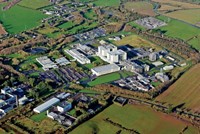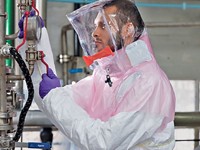Advertisement
Grab your lab coat. Let's get started
Welcome!
Welcome!
Create an account below to get 6 C&EN articles per month, receive newsletters and more - all free.
It seems this is your first time logging in online. Please enter the following information to continue.
As an ACS member you automatically get access to this site. All we need is few more details to create your reading experience.
Not you? Sign in with a different account.
Not you? Sign in with a different account.
ERROR 1
ERROR 1
ERROR 2
ERROR 2
ERROR 2
ERROR 2
ERROR 2
Password and Confirm password must match.
If you have an ACS member number, please enter it here so we can link this account to your membership. (optional)
ERROR 2
ACS values your privacy. By submitting your information, you are gaining access to C&EN and subscribing to our weekly newsletter. We use the information you provide to make your reading experience better, and we will never sell your data to third party members.
Business
Peptide Manufacturers Stake Out Their Positions
Contract producers gauge the pipeline to size their plants and fill out their services
by Rick Mullin
April 27, 2015
| A version of this story appeared in
Volume 93, Issue 17

The hermetic world of bulk peptide manufacturing brought forth news in February when one of the four major players, Bachem, acquired American Peptide, a midsized firm in Sunnyvale, Calif. The deal, which includes a plant not far from Bachem’s U.S. facility in Torrance, Calif., did little to alter the competitive landscape in peptides, however, other than to give the Swiss firm access to production capacity, in case something happens in peptides.
Like others in contract peptide manufacturing, Bachem has its eye on the new drug pipeline, in which peptide therapeutics are advancing steadily, even if commercialization is sporadic. Peptides made a strong show last year and in 2012 but scored zero Food & Drug Administration approvals in 2013.
Nonetheless, the handful of big producers have bulked up on reaction vessels and readjusted service portfolios to meet an anticipated increase in demand for bulk peptides.
One of them, CordenPharma, took shape in recent years with the acquisition of assets including a Roche plant in Boulder, Colo., that manufactures the active pharmaceutical ingredient (API) in Fuzeon, an HIV/AIDS drug. The other major players, PolyPeptide Laboratories and Lonza, have also been adding capacity and revamping plants.
Moreover, the majors have been assessing service offerings, including finished-drug production. The perennial debate over the wisdom of offering a one-stop shop in contract manufacturing simmers in peptides. Producers are also working out the ideal balance of workhorse generics and APIs for therapies in development.
“What is new with peptides is that we are in more discussions with customers,” says Martina Diekmann, Bachem’s head of global marketing. “We need to establish more technology internally so we can remain a good partner in the future.”
Diekmann points to a new peptide glycosylation and glycopeptide synthesis service that Bachem offers in partnership with GlyTech, a Japanese manufacturer of glycosylated drugs. Three of the six peptide drugs that debuted in 2012 were such glycopeptides.
Bachem first worked with GlyTech on manufacturing generic interferon β-1a, according to José de Chastonay, Bachem’s chief marketing officer. In the project, Bachem gleaned the benefit of producing glycosylated drugs chemically rather than through recombinant processes. “We believe there is a trend toward longer peptides chemically manufactured,” he says.
Earlier this month, Bachem formed a collaboration with the University of Chicago on developing technology for the synthesis of complex peptides and small-protein therapeutics.
Bachem’s sales of peptides for new chemical entities (NCEs) grew 16% last year, compared with 8% for generics. The relative strength of the NCE business is “a bellwether of future sales trends for the company,” de Chastonay says.

As sales grow, volume becomes a consideration. De Chastonay says the firm has built its own 1,000-L reactors and is studying building one twice that size. “Typically, 150-L reactors for peptides were large. Now you find 300-L,” de Chastonay says. “We make 1,000-L reactors, which allow us to manufacture efficiently with batch sizes of 20 kg or more.”
Novo Nordisk’s liraglutide, a type 2 diabetes drug, launched in 2010 as the first landing of a “new wave” of peptide drugs that will require large quantities of APIs. “In the old days,” he says, “if you made 100 g, you were covering a good chunk of the market. Now it’s kilograms, multikilograms. Tens of kilograms. Hundreds,” notes de Chastonay.
Peptide manufacturing has also been veering toward solid-phase synthesis, de Chastonay says, because of general manufacturing efficiencies. But the firm is staying on top of solution-phase production to serve existing customers. One example is goserelin acetate, the peptide active ingredient in AstraZeneca’s Zoladex, which is used to treat hormone-sensitive cancers.
Bachem is expanding its operations in Switzerland and at its Torrance site, which the firm bought in 1996 and which still has an empty building. But it will be another 18 to 24 months before the firm is ready with new capacity—thus the American Peptide acquisition.
“With this acquisition, we have gained instant access to capacity,” de Chastonay says. The firm, which in recent years has had to transfer work from Torrance to Switzerland when projects scaled up, will now be able to follow through in California.
PolyPeptide, a Swedish firm, also has two facilities in California, as well as one in Strasbourg, France, that it acquired from Isochem in 2007. According to Trishul Shah, associate director of business development, the company is focused strictly on peptides but is exploring ancillary technologies through collaboration.
Last October, PolyPeptide entered a partnership with Amunix under which it will have access to Amunix’s recombinant technology for peptide conjugation, an area of increasing customer interest, according to Shah. “We saw years ago that making straight peptides was not the only thing,” he says. “There were a lot of conjugates coming to market.”
“GlaxoSmithKline just had albiglutide approved,” Shah points out, “a recombinant peptide with an albumen group. So you are seeing a more diverse environment that requires a little more complex chemistry—more interesting chemistry, to say the least.”
PolyPeptide does most of its conjugation work in Torrance, Shah says, and the firm’s San Diego plant handles small-scale projects. Shah characterizes the company’s Strasbourg facility as a functional combination of its two California sites. The plant at its headquarters in Malmö is for contract API manufacturing in multikilo batches, and a plant in India manufactures generics.
Generics, Shah predicts, will become increasingly important. Here, too, executives speak of the promise of things to come, specifically the introduction of biosimilars or generic biopharmaceuticals. Liraglutide will come off patent in 2017, for example.
The geographic spread of the major peptide manufacturers results largely from acquisition and consolidation. CordenPharma’s peptide business was built from Peptisyntha in Belgium, Genzyme Pharmaceuticals in Switzerland, and the Roche facility, which at the time of its acquisition in 2011 was the largest-volume peptide API producer in the world.
According to Mimoun Ayoub, director of CordenPharma’s peptides business, the company aims to set up a one-stop shop for peptides, offering services ranging from preclinical supply to final drug product. He says the market is primed for the approach.
“The biotech segment is looking for a fully integrated service,” he says, and major drug companies are trending in this direction as well. The pinnacle of this offering is drug product, Ayoub says, noting that CordenPharma can offer peptides, carbohydrates, lipids, and related conjugates.
Lonza, the other major producer, recently completed an overhaul and expansion of its Braine l’Alleud, Belgium, facility, which it acquired from the Belgian drug company UCB in 2006, according to Michael Markus, Lonza’s associate director of commercial development. The firm also manufactures peptides in Visp, Switzerland, and Nansha, China.
“Lonza certainly has one of the largest offerings in peptides, with facilities for solid-phase and liquid-phase production,” Markus says. The company has vessels ranging up to 800 L for solid-phase synthesis and up to 2,500 L for liquid-phase in Braine l’Alleud.
Lonza, Markus notes, is a leader in antibody-drug conjugates and is receiving “constant inquiries for peptide-drug conjugates where peptides are the active drug ingredient and connected to the antibody itself or where it acts as a targeting agent and is attached to a cytotoxic ingredient.”
Lonza counts spray drying as a continuous isolation technology among its specialty services and claims to be the only peptide producer that can also support customers with microbial manufacturing technology at its facility in Visp.
The larger players agree that consolidation may not be over. Most have their eye out for deals that could land new technologies or services. But some of the better prospects have no interest in being acquired. AmbioPharm has set its sights on independently establishing a full-life-cycle services and manufacturing business that incorporates drug product.
“We have been approached by the large guys, but we have not accepted any offers,” says Jim Hampton, head of business development at AmbioPharm, a North Augusta, S.C.-based company with manufacturing there and in Shanghai. Hampton says these companies are driven by the need to offer downstream services—and ultimately finished-drug product support.
Hampton says AmbioPharm, a private company that he and three other former drug industry executives launched in 2007 with the acquisition of a UCB facility, makes generic peptides and APIs for drugs in development at about equal volumes. He notes that the two businesses are fundamentally different. “APIs are a fee-for-service business, whereas generics are a speculative business that requires a lot of up-front investment with a big payoff if you get approval from FDA,” he says.
AmbioPharm is interested in manufacturing finished-drug products, which Hampton says can yield as much as 10 times the profits that can be achieved from making APIs. “It just takes a long time to get into that business,” he says.
AmbioPharm is beginning with generics. “The way we sell drug product is by partnering with people with infrastructure in place. We might go into a place like Russia and try to find a partner,” Hampton says.
Almac, the Northern Ireland-based life sciences services firm, also provides drug product services such as fill-finish for peptides through partnership. But the company, which offers a diverse menu of chemistry and biology services, says it can do most of the work of a one-stop shop on its own.
The company began working on peptides 10 years ago, at about the time it launched a program called Rapidd, which combined drug development offerings from all of its service units. “Six or seven years later, I would say that peptides have been the main beneficiary of the model,” says Denis Geffroy, vice president of business development. “The fact is that we’ve taken more peptides through the Rapidd model than small molecules. That wasn’t our plan, but we aren’t complaining about it.”
Peptides are now about 25% of the sales of the company’s API services division. “I don’t know where they will be in 10 years, but they are growing faster than small molecules,” Geffroy says. Earlier this month, Almac said it will relocate its custom peptide synthesis operation from its current facility in Elvingston, Scotland, to a newly built wing of the Edinburgh Technopole.
Geffroy points to conjugates as an important stimulus for growth in peptides. Whereas other exectutives emphasize the importance of focusing strictly on peptides, Geffroy sees Almac’s strength in small molecules as an advantage, noting that the firm has developed technology for small molecule-peptide conjugation.
As contract manufacturers align themselves to keep pace with innovation in research and the likely need for future manufacturing capacity, their eyes are on the drug development pipeline. Still, business managers admit that it’s difficult to predict the size and shape of any wave of new peptide drugs.
“There is certainly a lot of activity with new compounds going into the clinic,” Lonza’s Markus says. “At the moment, it is good to get new products into the portfolio and into clinical phases. How successful it all is, we will have to see.”






Join the conversation
Contact the reporter
Submit a Letter to the Editor for publication
Engage with us on Twitter